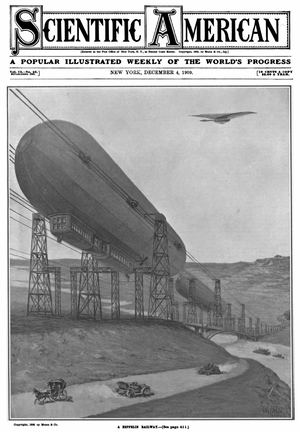Scientific American
Scientific American was and is a widely read American periodical with science news and editorials. The magazine was founded by 1845 by Rufus Porter and soon thereafter bought by Orson Desaix Munn and Alfred Ely Beach of Munn & Co. The company's work as patent solicitors was interwoven with its publication strategy, which emphasized inventions and encouraged Americans to apply for patents.[1]

Before 1850, Scientific American typically ridiculed predictions of sophisticated flight. However the magazine soon became a big booster of aero.[2][1]
The Internet Archive has a collection of Scientific American issues through 1909. The covers of which make clear that aeronautics and aviation were important themes for the magazine. More scans of these issues, as well as later issues (available up through the end of public domain period) are available from HathiTrust.
Articles of interest
References
- ↑ 1.0 1.1 Scientific American "About Scientific American", accessed 5 April 2019.
- ↑ Black, 1943, pp. 29–30. "A modern reader, thumbing over the yellowed pages of old technical journals, is left with the distinct impression that editors of these bygone years regarded mechanical flight as far too imaginative to warrant space in their conservative publications. Taking the Scientific American as typical, mainly because of the universality of its interest, we find the editor ridiculing the January, 1847, proposal of a Mr. Wise of Lancaster to use for aerial bombardment a war balloon 100 feet in diameter. By September, 1848, we come across a brief reference to the reports of Stringfellow's now historic experiments with flying models in London. To this the editor humorously appends the proposal that Stringfellow's flying machine be used for 'exploring the River Niger.' A few months later the reports must have come back to mind, for the editor comments that 'since that [then?] we have heard no more about it, and presume that it met the fate of its predecessors.' By 1851 or so we find references to balloons and flying machines becoming more frequent, reflecting the progress actually being accomplished. But what is most significant is the absence of the humorous editorial comment that was formerly appended to each report."